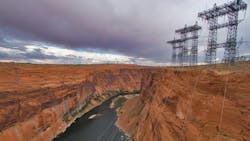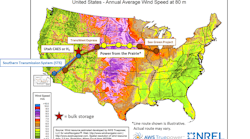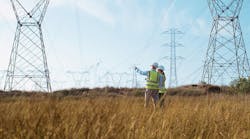Better Neighbors: The Case for a More Cooperative Power Grid
The North American Electric Reliability Corporation recently released its latest glance at the interregional needs of the power grid, and recommended an increase of 35 GW in interregional capacity to address the shortfalls that accompany extreme weather conditions. The experts agree that this is a great start, but the North American grid can do a lot better than just keeping the lights on — and indeed needs to.
“The key takeaway for me is we need to get building,” said Allison Clements, former FERC Commissioner, referring to NERC’s study.
During a conference call organized by the American Council on Renewable Energy, Clements said she felt NERC’s study confirms what many in the industry already suspected: that the U.S. and North America need to beef up its interregional transfer capabilities.
“We are in the middle of a transition. Things are changing and this country needs to build all kinds of infrastructure,” Clements said. “We realize we can’t start picking which kinds of infrastructure and preferring one without really doing the analysis. We need all kinds.”
Clements went on to name load growth from many sources, intensifying extreme weather affecting broad areas and national security concerns about the supply of reliable electricity as several pressures the power grid is currently under.
A study performed by Grid Strategies and commissioned by ACORE found that if, during 2021’s Winter Storm Uri, ERCOT had access to just another gigawatt of interregional capacity between ERCOT and the Southeast, Texans could have saved $1 billion in power costs. Other severe weather events, such as the “bomb cyclone” of December 2017 that struck the Northeast, the polar vortexes that struck the Northeast in 2014 and the Midwest in 2019, as well as the August 2019 heat wave that hit Texas, have shown that the impact of these disasters can have interregional consequences.
The Role of Transmission
Robert Taylor, vice president of Transmission, New Markets, for power generation developer and owner/operator Invenergy said many studies have confirmed the need for more cooperation between regions in North America, but getting NERC to underscore that need is important.
“I was driving home on Christmas Eve, I live in Chicago and was going back home to east Tennessee. My parents had rotating power blackouts in east Tennessee and western North Carolina because there wasn’t enough generation capacity and there wasn’t enough transmission capacity to import the power,” Taylor said, adding that the middle of the country was curtailing wind power at the time, but lacked the ability to send it to where it was needed.
Taylor said Invenergy’s flagship project is the Grain Line Express, a 5 GW, 800-mile line that connects three regional transmission organizations together.
“Most of the RTOs today view merchant transmission essentially as a generator. So, you are seen as injecting power, and if you want to have rights to withdraw power and send to the other regions, then you’re viewed as load. So they assume you are going to be withdrawing those megawatts at peak load in their zone, even though that’s not functionally the way you’re going to do these things,” Taylor said.
He said rationalizing the processes involved in interregional transmission operation could be helpful. Another means of relieving stress on the grid could be intertie optimization, or working to maximize the efficiency of the interregional ties that already exist.
“Intertie optimization is one of those things that’s so obvious, you wonder why we aren’t taking this on by now,” he said. “You have existing systems that don’t necessarily let you schedule power in real time. You have to make nominations well in advance and the system changes.”
Studies have shown, he said, that there are times of year where un-optimal nominations have forced RTOs and transmission providers to pull power from where it is needed and deliver it to where it is plentiful, with ratepayers ending up paying for the inefficiency. Events like these increase costs and decrease the reliability of system assets at the times they are needed most, he said.
Merchant transmission corporations like Invenergy can be, in effect, a life insurance policy for grid operators.
“Merchant transmission is not going to build us out of the interregional transmission need that we are going to have, but I think it’s got a role to play. With the costs we are anticipating for some of this buildout, I think it’s a really important piece to be able to balance some of that out,” he said.
Spurring Transmission Expansion
Getting to a more reliable power grid will require all the tools in the toolbox, including power generation and grid enhancing technologies, but transmission will play a key role, Clement said.
“Also, remember it’s FERC’s job to protect customers. I wasn’t a champion of transmission just because I think transmission is great. In fact, it would be a lot easier if we didn’t have to build it. I’m a champion of transmission because it is the way to get to cost effective reliability for customers,” Clement said.
To encourage the kind of transmission buildout that is needed, Clement said with the new administration in charge, states should do what they can to support FERC to take action, as state-level policy choices will not be enough to boost reliability, as the issue affects entire regions. This could be a moment of opportunity for FERC.
“FERC should take action on planning and cost allocation for interregional planning. And of course, as much as FERC can do, we still need Congress to act to ensure we can get interregional transmission built from a siting and cost allocation perspective,” she said.
At this time, FERC should focus on the quick and easy ways to boost system reliability, she said, such as installing grid enhancements, improving efficiencies, exploring surplus connections, and then moving on to the harder, more expensive facets once progress is made, she said.
However, at the time this story was being written, reports came in of a White House executive order claiming greater scrutiny over independent agencies like FERC and requiring that new regulations originating from them to pass through the Office of Management and Budget’s Office of Information and Regulatory Affairs. As is typical with such executive orders, the actual impact on the industries FERC oversees and the future of its work are unclear at the moment.
Strategic Value
The Trump Administration has frequently mentioned energy as a national security issue, as have many administrations before it. Cy McGeady, a Maryland-based fellow in the Center for Strategic International Studies’ Energy Security and Climate Program, said there is a strategic value to reliable electricity that is often difficult to quantify, but which helps those who have it compete better in the global marketplace.
Growing investment in artificial intelligence, data centers, onshoring of manufacturing, and the electrification of transportation and housing each have two things in common: They are both potential drivers of economic growth, and they both require enormous amounts of cheap, reliable electricity to be profitable.
“So, you think about demand. Well, what is demand? The whole purpose of the system is to serve demand. The demand is serving industries that create jobs and economic value,” McGeady said, noting that both Trump Administrations and the Biden Administration called for the US to become a leader in the above arenas. “When you look downstream from that, all of a sudden, transmission takes on profound strategic implications, right?”
McGready pointed to northern Virginia, home to one of the largest clusters of data centers in the world, some of which is tied in with the US national security apparatus. The technological growth and commercial potential at play here both indicate that this cluster will need to grow by double or triple.
“How do you get power into that little corner of the grid? Well, it’s going to have to come from the Midwest. It’s going to have to come from the South. It’s going to have to come from the North,” he said.
There are power plants that may have to fire up at higher use rates, but are unable to if they lack enough transmission capacity. This calls for a more robust power grid infrastructure all around.
“So, it’s not a resource specific issue here. Any and all resources on the grid today and in the future, need to find ways to access these demand clusters that have strategic value above and beyond all these other value assessments,” he said, adding transmission expansion needs to be thought of as a matter of national security.
A Conservative Estimate
Greater reliability is just one of the benefits in boosting interregional transmission, said Michael Goggin, vice president of Grid Strategies, a consulting firm covering power grid issues. The amount of new capacity recommended by NERC’s report would be in some ways the bare minimum, Goggin said.
“This is the amount of transmission you would want to build if you are just trying to keep the lights on. The optimal amount, the amount that would save your generating capacity, reduce your cost of producing electricity, give you more competition and greater resilience against extreme and unexpected events, all of that is on top of this. So, this is really the floor of what you should be thinking about in an optimal transmission expansion,” Goggin said.
For the purposes of the study, FERC was only asked to look at smart additions to transmission for reliability, or the bare minimum for keeping lights on. The 35 GW in interregional capacity estimate is a conservative one, and does not account for opportunities such as cutting consumer costs by providing cheaper power. It also does not look at how transmission can help you share generation capacity.
Goggin called for “making the grid bigger than the weather,” meaning using grid interconnections across regions to address the sort of power crunches that happen when extreme cold shuts down power plants, leading to a downstream collapse in ability to serve customers — exactly the thing that happened in Texas in February 2021. These kinds of benefits were outside the scope of the study, but would be a way to save money and prevent the disruptions caused by lack of power.
“We looked across the Eastern Interconnection and ERCOT and found that if you were able to build enough transmission to fully share resources across that footprint, you could reduce the need for generating capacity by 137 GW. That’s about 21% of the peak load of that area,” he said, comparing this to the 35 GW figure mentioned in the NERC study.
Like a Good Neighbor
NERC’s study also did not consider what the Goggin and Taylor called the “neighbors of neighbors” issue, which is the unrecognized potential of drawing power from sources beyond the closest neighbors of the grid operator needing power at the moment.
“In many cases, there were opportunities to build transmission beyond your immediate neighbors,” Goggin said. “If you were able to build a larger transmission network, build a national network, or at least look beyond immediate neighbors by maybe building a direct current tie across your neighbor or building an alternating current line through your neighbor and then to their neighbor, I think you would be able to keep the lights on in more hours than the NERC study did.”
Building connections such as these could lead to as much as 60 GW in increased interregional capacity, he said. Establishing better relationships between neighbors could, in this way, be much more cost effective than massively overbuilding the transmission system.
Positives
Clements said it isn’t all doom and gloom, naming several recent improvements.
“I would look at this report in conjunction with NERC’s annual winter assessments that they put out relatively recently for 2024 and 2025. Those are affirming that, again, we are not in a static place. In a lot of ways, things are getting better. We have changes in capacity contracts that are affecting prices but also are starting to move in a good direction,” she said.
Also, FERC approved some new extreme cold weather reliability standards during Clements’ tenure there, she said, which should help natural gas power generation be more reliable and prepared when temperatures drop.
Goggin said winterization standards pushed forward by FERC and NERC will, once fully implemented, require regions to look at extreme heat and extreme cold when planning transmission.
“Hopefully this will drive them to build more transmission to counteract the risks of these extreme heat and extreme cold events,” Goggin said.
About the Author
Jeff Postelwait
Managing Editor
Jeff Postelwait is a writer and editor with a background in newspapers and online editing who has been writing about the electric utility industry since 2008. Jeff is senior editor for T&D World magazine and sits on the advisory board of the T&D World Conference and Exhibition. Utility Products, Power Engineering, Powergrid International and Electric Light & Power are some of the other publications in which Jeff's work has been featured. Jeff received his degree in journalism news editing from Oklahoma State University and currently operates out of Oregon.


